Friday, April 23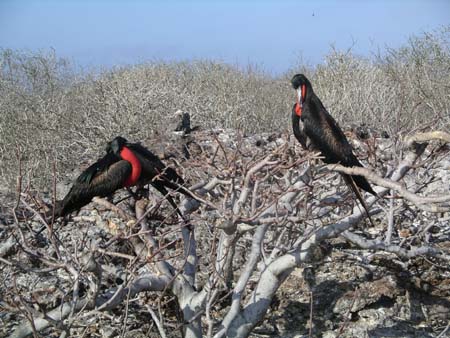
Steve: We must have cruised overnight, because when we woke up this morning (6:30 wakeup call this time…), we were in the middle of Darwin's bay on Genovesa Island. This is a very beautiful location, with a pristine beach surrounded by rock cliffs extending to either side. This bay was actually once a volcanic crater, which explains its horseshoe shape.
This morning's adventure included a walk on Genovesa Island followed by a dinghy ride along the cliffs. Genovesa Island felt like an entirely different world from yesterday's visit to Espanola Island. Genovesa is very desolate, and there is very little green vegetation. Most of the trees are waiting for rain (it's a particularly dry season now), and have no leaves. Much of the island has no vegetation at all - just ancient volcanic rock. As we walked here today, it was easy to understand why all the American and Spanish explorers (especially those that preceded Darwin) essentially considered these islands to be useless and ugly lands.
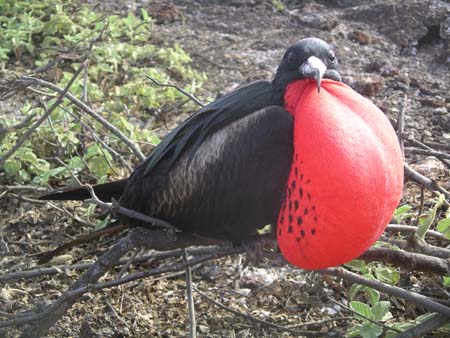 As
soon as we set foot on the Genovesa, we were treated to the amazing spectacle
of Galapagos frigate birds during mating season. During this time of year,
the male birds inflate their bright red pouches, find a suitable spot for
a nest, and watch overhead for a female flying by. When a male spots a potential
mate, he begins wildly shaking his wings and head, at the same time making
a loud gobbling noise. This is all in effort to attract a female to land and
mate. It's really an incredible sight!
As
soon as we set foot on the Genovesa, we were treated to the amazing spectacle
of Galapagos frigate birds during mating season. During this time of year,
the male birds inflate their bright red pouches, find a suitable spot for
a nest, and watch overhead for a female flying by. When a male spots a potential
mate, he begins wildly shaking his wings and head, at the same time making
a loud gobbling noise. This is all in effort to attract a female to land and
mate. It's really an incredible sight!
We are very lucky to be here during the mating season for so many species of Galapagos birds. On Genovesa Island, the frigate birds are everywhere, and we couldn't stop watching the spectacle of the male birds with their amazingly bright red pouches carrying on their courtship routine. It was also fun to see several happy couples, with the male birds' wings placed around their mates much as humans put their arms around each other. Very cute.
Interestingly, the frigate birds are unable to fish themselves, lacking the ability to produce the oil necessary to protect their feathers. Instead, they commonly steal food from blue footed boobies, often harassing them until the boobies regurgitate recent meals. Not very nice!

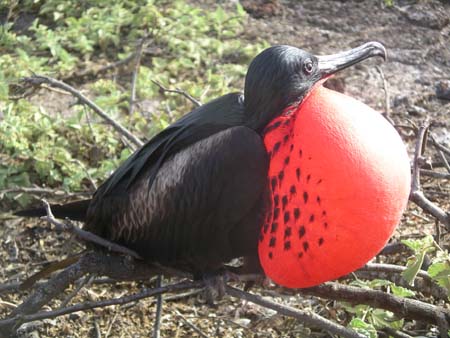
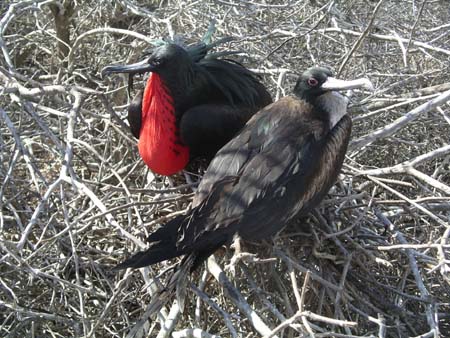
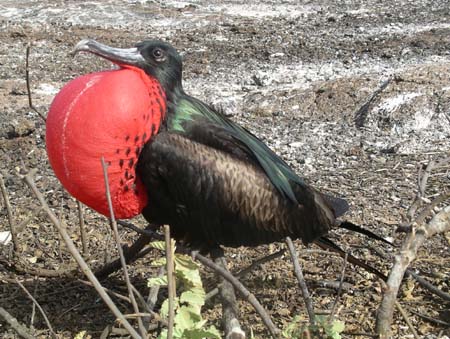
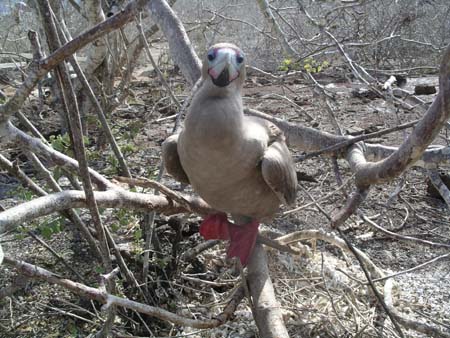
The other primary bird that we saw today was the red footed booby, which
actually descended from the blue version. As opposed to the blue footed boobies,
these birds nest in trees, and it was easy to spot them today since the trees
have no leaves. 95% of these birds are brown with blue beaks and red feet
- a particularly beautiful combination. The other 5% are of 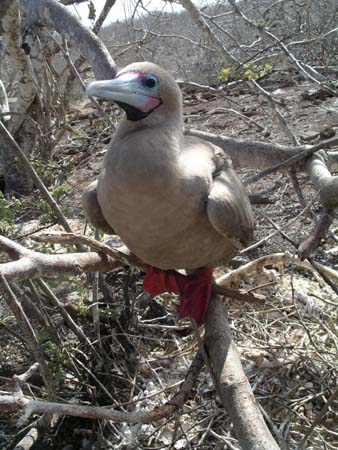 a
white variety. These birds weren't as plentiful as the blue footed boobies
yesterday, but we did see several in the trees that lined our trail. We have
been told that this is the only island where we'll see these very unique birds.
a
white variety. These birds weren't as plentiful as the blue footed boobies
yesterday, but we did see several in the trees that lined our trail. We have
been told that this is the only island where we'll see these very unique birds.
Here are some of our favorite red footed booby pictures...
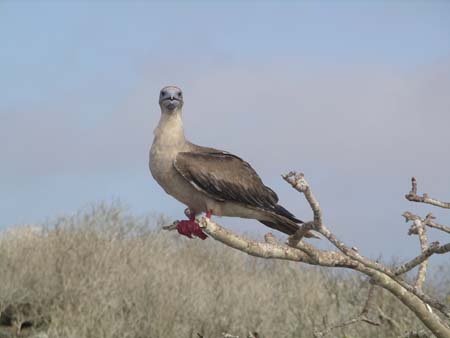
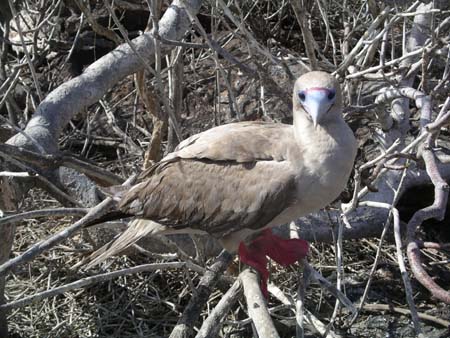
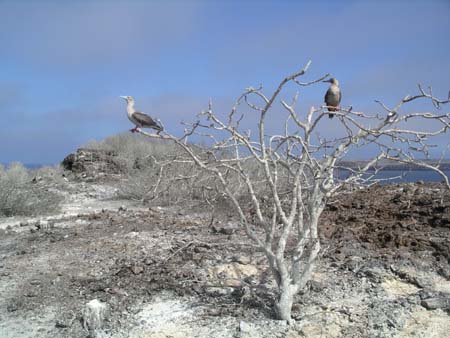
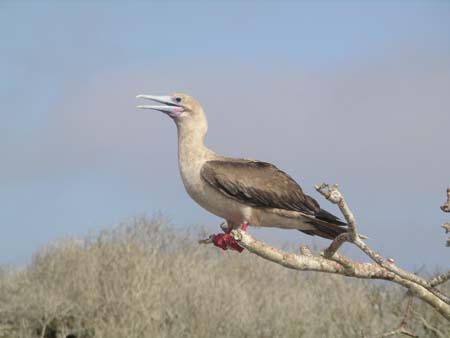
We also spent time looking for the rare short-eared owl on Genovesa Island. With the help of our naturalist, we did manage to see one of these large birds flying among a huge flock of storm petrels, a small bird that also lives here and is preyed upon by the owls. These two pictures show some more of the landscape on Genovesa, and also how close we can get to these tame birds.
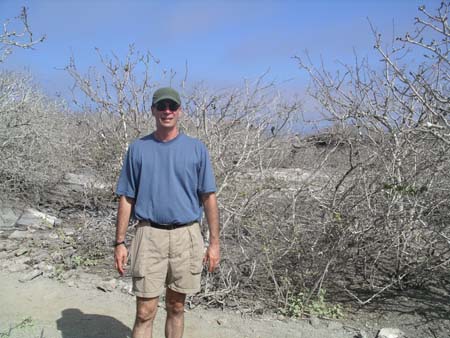
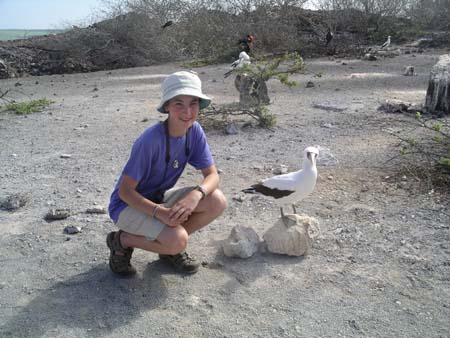
The following picturesw are all of nazca boobies, and also some shots of the kids working to get great shots of them... (most of the following pictures were taken by David)
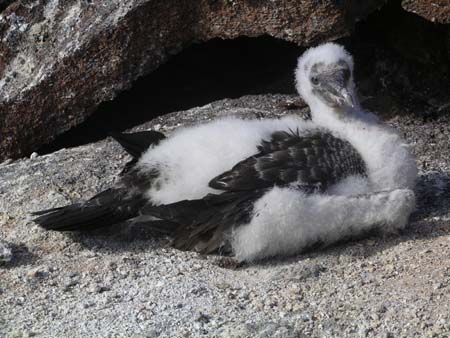
This one is a juvenile, born within the past month.
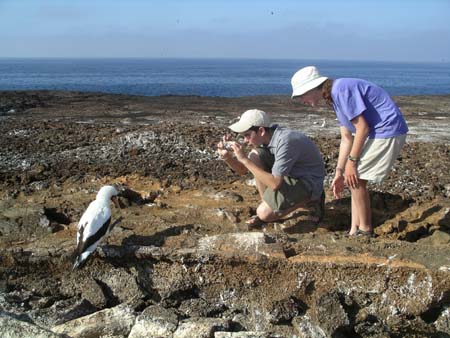
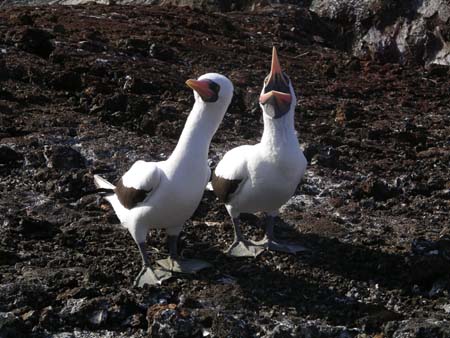
.jpg)
.jpg)
.jpg)
.jpg)
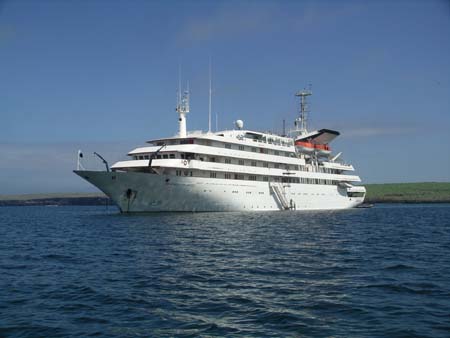
After our hike, we took a dinghy ride along the cliffs of the island, looking at nesting birds, resting sea lions and a smaller species of marine iguana. Shortly after we started, the fin of a hammerhead shark became visible near our boat. An interesting sighting, since this is where we were told that we would be snorkeling in the afternoon…
Our afternoon excursion found us back on the island, this time arriving at the beach on Darwin's Bay. As we disembarked from our dinghy, we saw many adult and juvenile sea lions lounging around on the beach and playing in the shallow waters. These guys are everywhere! We took pictures of David and Katie next to these friendly inhabitants.
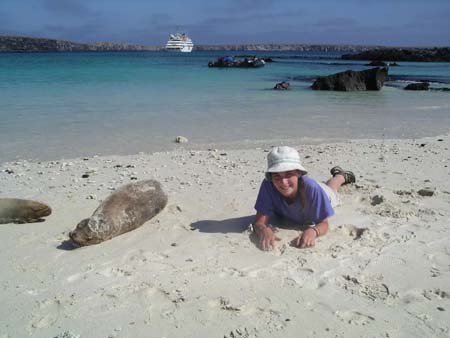
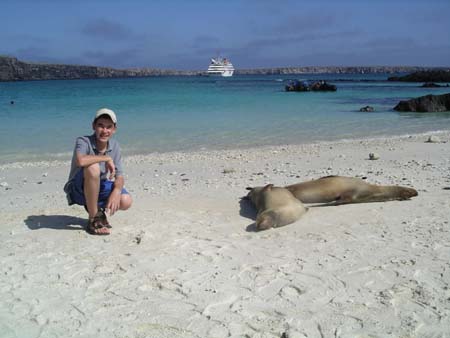
We then took a short walk in the area immediately behind the beach to see huge numbers of frigate birds all engaged in the same courtship and mating activities that we saw this morning. Here, the birds were even more accessible than this morning, and it was fun to watch multiple males simultaneously trying to attract a single female.
We saw several more of the Sally Lightfoot crabs with their amazingly bright red/orange coloring. After taking pictures of one of these guys (they're also so tame that we were able to get up close for photos), I actually almost stepped on a sea lion that I didn't realize was right behind me. Fortunately, she barked just as I was about to run over her…
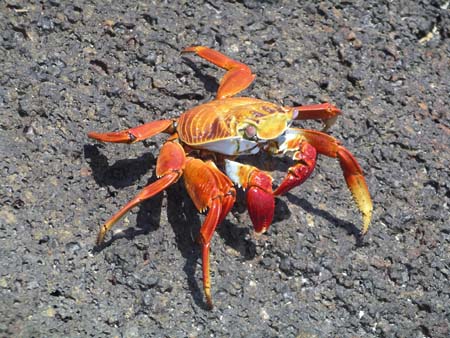
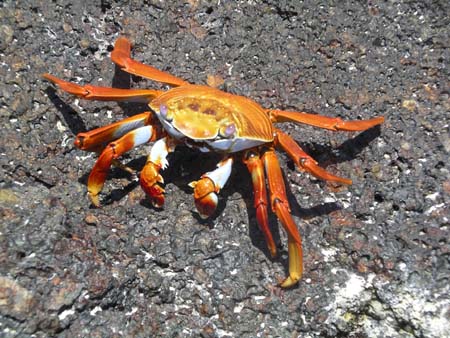
Genovesa Island is also home to the beautiful swallow-tail gull, which almost looks like a stuffed animal when viewed up close...
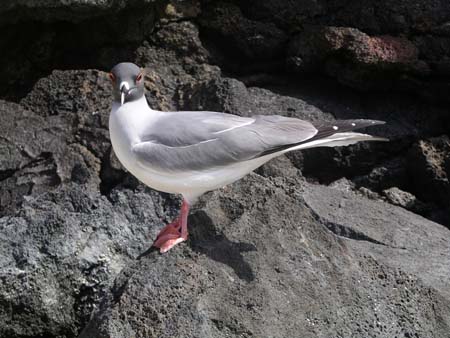
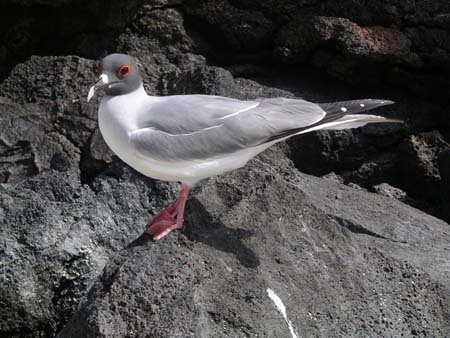
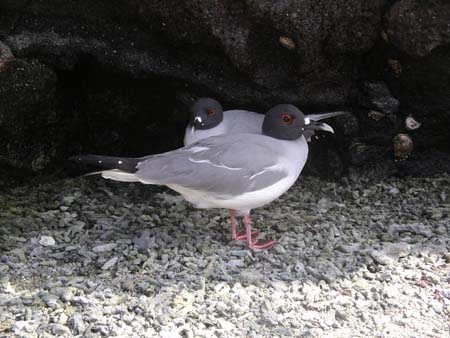
It was also fun to see a red-footed booby that was hanging upside down and sleeping!
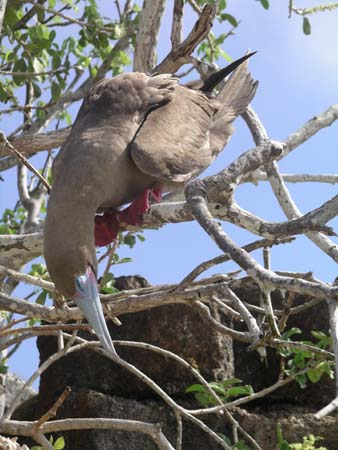
After our walk, it was time to snorkel. We started with a snorkel from the
beach, with the highlight being 4 very large reef sharks that we encountered
sleeping beside a rock in very shallow water. We had been told that people
often see sharks right off the beach, but we never expected them to be quite
so large. The water was only waist-deep, and we literally could have stepped
on them if we had wanted. I wanted to stay and observe, but Paula would have
none of it and we quickly swam clear…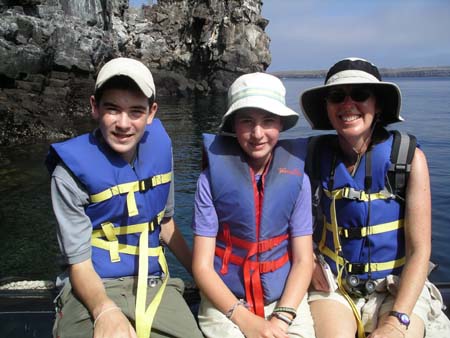
After our short snorkel from the beach, we headed out in dinghies for "deep water" snorkeling along the cliffs of the island. The idea here was to stay close to the rocks, observing the varied marine life that feed and live here. We were all experiencing some anxiety because of the hammerhead shark sighting this morning, but our naturalists assured us that the sharks here are "safe" and that they've never had any problems. They told us that we'd be "lucky" to see one, and to have our cameras ready. So we simply jumped in off the side of the dinghy and set off.
The fish along the cliffs are large and colorful, but not as abundant as what we had seen in Australia. However, we were thrilled with the opportunity to swim with a large sea lion that took a particular interest in the four of us. She kept circling around and under us, and several times swam directly at our masks before diving below. We had heard that we may have the opportunity to see playful sea lions while we snorkeled, but we assumed that these would be small pups. This particular one was clearly a full-grown female, and it was great fun to watch her swim all around. The size and agility of these animals is truly amazing, especially viewed at such a close distance.
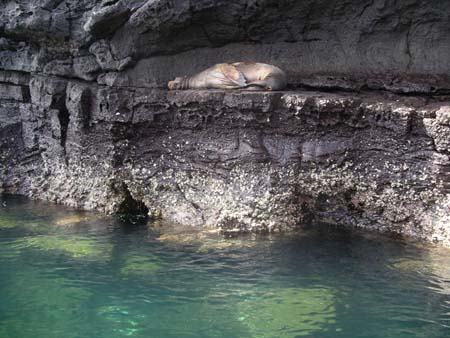 Paula
and Katie also spotted a very large ray below them, and we all enjoyed seeing
some large parrot and angel fish. The water was surprisingly cold - we're
all used to snorkeling in much warmer temperatures. Our naturalist told us
that this is some of the warmer water that we'll be in, so our snorkeling
excursions later in the week could be very interesting…
Paula
and Katie also spotted a very large ray below them, and we all enjoyed seeing
some large parrot and angel fish. The water was surprisingly cold - we're
all used to snorkeling in much warmer temperatures. Our naturalist told us
that this is some of the warmer water that we'll be in, so our snorkeling
excursions later in the week could be very interesting…
By the end of the day, we were all totally exhausted! The combination of the hot sun, followed by our hour-long cold water snorkel had taken everything out of us, and we all crashed immediately after dinner.
Tomorrow we head back to San Cristobal Island. Our boat operates in a figure-eight pattern, picking up and dropping off passengers every Saturday and Wednesday (we're on a Wednesday-to-Wednesday schedule). Our activities will include an excursion to a fresh water lake, a visit to Sea Lion Island and time to swim and snorkel on a beach.
Katie's Kwick Kwacks: Blue-footed Boobies in the Galapagos Islands.
We all watched in amazement as the bird moved his blue feet up and down in
place. It then began to whistle loudly and stretch back its majestic wings.
This bird was performing what we like to call "the booby dance."
This dance is used by males to attract mates. Who knows how females find this
attractive, but hey-it was entertaining.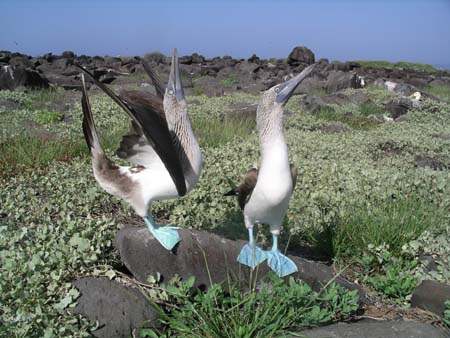
The blue-footed booby is one of three kinds of boobies here on the Galapagos Islands. Although many people believe the species' unusual blue feet are the most interesting part of these birds, we found them to be beautiful and distinctive in other ways as well. First, I'll describe the bird's visual beauty. It has beautiful black and white feather variations all up its slender neck, large detailed wings, a round plump belly, and a pointy gray beak. The eyes are stunning. When they look at you, their big black pupils seem to pull you in, and their round irises are extremely vivid. Their webbed feet are very large, and they waddle like penguins.
If you think the appearance of these birds is impressive, than wait till you hear about their behavior. During mating season, the blue-footed boobies perform some special rituals in order to find a partner. When the males spot a female close by, they perform "the booby step dance." They begin this courtship by slowly stepping in place with their blue webbed feet. They then extend and bend their wings behind their body, arch back their slender necks, and whistle loudly. Their striking blue feet contribute to attracting the female's attention. They repeat this procedure over and over again until one is interested. The female comes over and joins the male in his dance--the male whistles and the female honks. If all goes well, they perform a fascinating ritual which involves exchanging various twigs and feathers with their beaks as gifts. You can relate these to a sort of engagement ring--the only difference is they represent just one year.
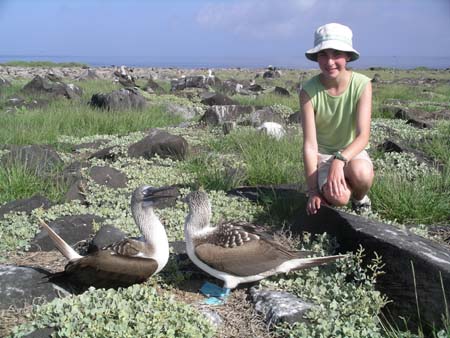 The
most fascinating thing about this exchange is that they give each other these
items (twigs, rocks, feathers etc.) because they find them valuable. Before
they evolved to their common state here in the Galapagos, they had to build
nests as protection from predators. Now that they have no predators, however,
they have learned that nests are not necessary. It is still in their instinct
to pick up and play around with these nest building items, and they find them
to have special meaning today. We also saw the couples talking among themselves,
nuzzling noses, and cuddling with each other as part of their ritual before
mating. After mating, the female sits on her eggs for a period of about 41
days, and the chicks fledge 105 days later. The male birds repeat their routine
with a new female next mating season.
The
most fascinating thing about this exchange is that they give each other these
items (twigs, rocks, feathers etc.) because they find them valuable. Before
they evolved to their common state here in the Galapagos, they had to build
nests as protection from predators. Now that they have no predators, however,
they have learned that nests are not necessary. It is still in their instinct
to pick up and play around with these nest building items, and they find them
to have special meaning today. We also saw the couples talking among themselves,
nuzzling noses, and cuddling with each other as part of their ritual before
mating. After mating, the female sits on her eggs for a period of about 41
days, and the chicks fledge 105 days later. The male birds repeat their routine
with a new female next mating season.
Another interesting aspect of the blue-footed booby's behavior is how they
feed out at sea. We have been able to see a little of this, and have found
it to be both an amazing and startling experience. These birds feed on only
fish, and therefore spend large amounts of time at the ocean-some even nest
on edges of cliffs for convenient paths. They catch fish by flying over a
school, and then do a sharp dive straight down to catch an individual. It
was incredible to watch them zoom straight down like torpedoes-they weren't
afraid to do it right in front of our zodiac if necessary. Although we have
not witnessed this yet, we have heard that there are sometimes huge schools
of fish where the boobies dive straight down at the same time. This remarkable
behavior adds tribute to the birds' unique characteristics.
Watching blue-footed boobies has turned out to be one of the highlights on
the trip for me. Although there are three kinds of similar boobies on the
Galapagos Islands, the character of the blue-footed booby is considered to
be the most entertaining and dramatic.
I never knew how fun and lively birds could be! We had the opportunity to
see these birds during the fascinating months of their mating season-we saw,
heard and experienced everything I described in the first three paragraphs.
One thing that makes this so special is you can get really close to the birds. We were literally inches away from many of them, and the birds would remain seemingly unfazed. We were able to witness all of their normal actions and routines right up close. Some were curious, and would stretch their necks forward right in our faces. We could have nuzzled noses with them. There is so much to see and experience-I could have spent the entire day with those adorable creatures. It was great to observe their behavior while feeling like we were part of their group, and not a dangerous outsider.
David's Daily Dump: Galapagos Marine Iguanas. Yesterday we had our first close up (believe me, it was real close) look at the notorious Galapagos Marine Iguana on Espanola Island. This iguana, which is the only sea-going lizard in the world, was one of the coolest and most spectacular things that we saw all day (besides the blue-footed booby).
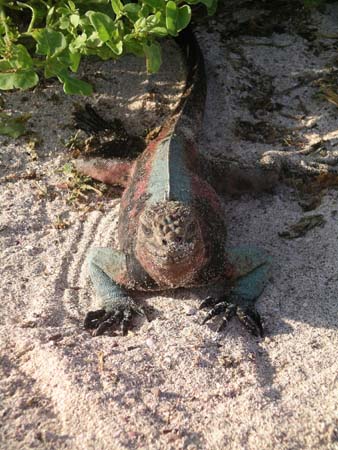 One
of the first things that we noticed as we walked along the trail on Espanola
Island were the magnificent marine iguanas. They were everywhere; on the trial,
in the sand, on the rocks, and even on the cliffs. We found them sitting in
big groups together on the rocks looking as if they were frozen in time. They
weren't scared of us the least bit, and it wasn't until you were about to
step on them that they move. They were extremely lazy, and seemed not to pay
any attention to us. It was amazing how close we could get to them too. I
could have picked one up by the tail or touched one's nose if I wanted. Some
were lying on the path just basking in the sun, and soaking up the rays. You
always had to watch where you were walking so that you wouldn't step on one.
If there happened to be an iguana on the path, you moved…not the iguanas.
One
of the first things that we noticed as we walked along the trail on Espanola
Island were the magnificent marine iguanas. They were everywhere; on the trial,
in the sand, on the rocks, and even on the cliffs. We found them sitting in
big groups together on the rocks looking as if they were frozen in time. They
weren't scared of us the least bit, and it wasn't until you were about to
step on them that they move. They were extremely lazy, and seemed not to pay
any attention to us. It was amazing how close we could get to them too. I
could have picked one up by the tail or touched one's nose if I wanted. Some
were lying on the path just basking in the sun, and soaking up the rays. You
always had to watch where you were walking so that you wouldn't step on one.
If there happened to be an iguana on the path, you moved…not the iguanas.
The marine iguana is one of the most fascinating animals in the Galapagos
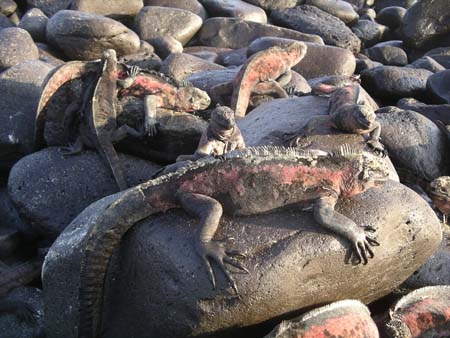 Islands. They have adapted to be great swimmers so that they can feast on
sea algae. The males can grow larger than 4 ½ feet and weigh over thirteen
kilos. They (males) can dive 30 feet deep out in the deep waters, while the
females and the babies dive in the shallows. The iguanas usually go to feed
at noon, and throughout the morning they sit and absorb the sun's energy.
They need to increase their body temperatures before going to the cool waters.
During the mating season, the male iguana's skin becomes red, black, and green
in an attempt to attract females.
Islands. They have adapted to be great swimmers so that they can feast on
sea algae. The males can grow larger than 4 ½ feet and weigh over thirteen
kilos. They (males) can dive 30 feet deep out in the deep waters, while the
females and the babies dive in the shallows. The iguanas usually go to feed
at noon, and throughout the morning they sit and absorb the sun's energy.
They need to increase their body temperatures before going to the cool waters.
During the mating season, the male iguana's skin becomes red, black, and green
in an attempt to attract females.
At first glimpse the marine iguanas are hideous and nasty looking. Their faces are ugly, their skin is rough, and the spikes on their head are gruesome, yet they have an unseen beauty to them. It was fun seeing and learning about this unique species of iguanas, one of the endemic species that evolved on the Galapagos Islands long ago.
